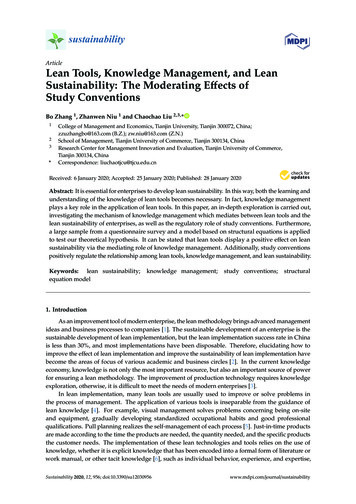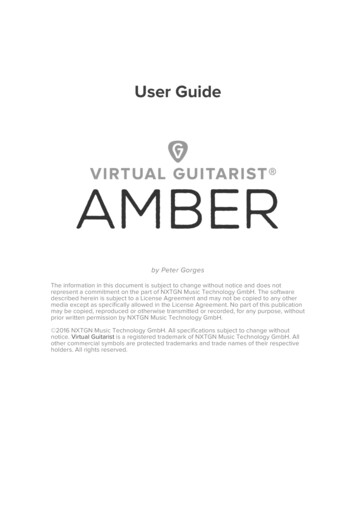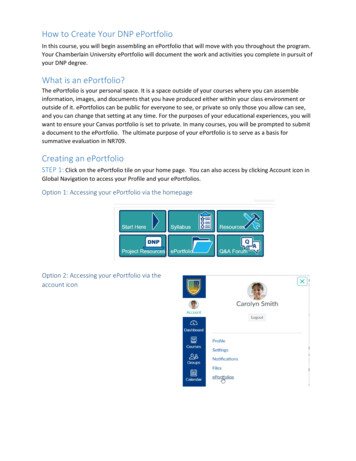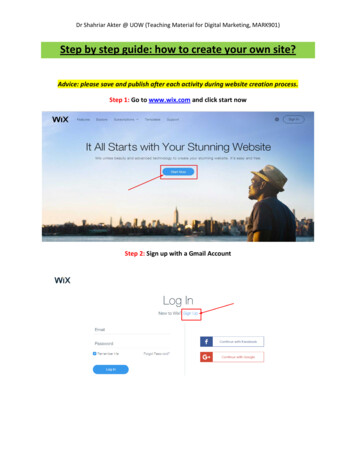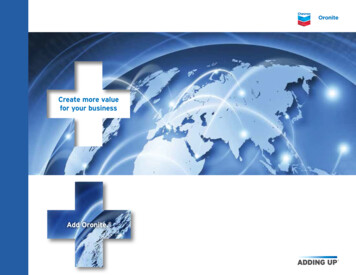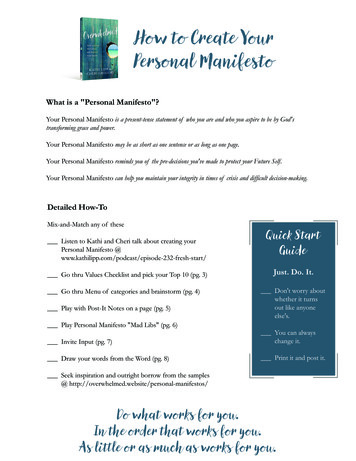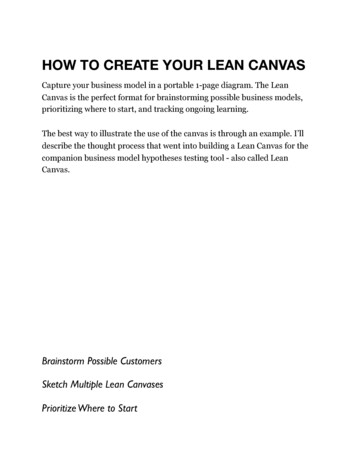
Transcription
HOW TO CREATE YOUR LEAN CANVASCapture your business model in a portable 1-page diagram. The LeanCanvas is the perfect format for brainstorming possible business models,prioritizing where to start, and tracking ongoing learning.The best way to illustrate the use of the canvas is through an example. I’lldescribe the thought process that went into building a Lean Canvas for thecompanion business model hypotheses testing tool - also called LeanCanvas.Brainstorm Possible CustomersSketch Multiple Lean CanvasesPrioritize Where to Start
2HOW TO CREATE YOUR LEAN CANVASBrainstorm Possible CustomersYou most likely already have an inkling of the problem, solution, andcustomer in mind. Start by brainstorming the list of possible customers youenvision using your product.1. Distinguish between customers and usersIf you have multiple user roles in your product, identify customers.A customer is a someone that pays for your product.2. Split broad customer segments into smaller onesI’ve worked with startups that felt the problems they are solving are souniversal, they apply to everyone.You can’t effectively build, design, and position a product for everyone.While you might be aiming to build a mainstream product, you need tostart with a specific customer in mind. Even Facebook, with it’s now 500million users started with a specific user in mind - Harvard collegestudents.3. Sketch a Lean Canvas for each customer segmentAs you’ll find shortly, the elements of your business model can and will varygreatly by customer segment. I recommend starting with the top 2-3customer segments you feel you understand the best or find mostpromising.
RUNNING LEAN3Case-study: Lean CanvasBackgroundIn the course of applying Customer Development and Lean Startup principles tomy products, I inevitably needed to document my business model hypotheses. Istarted with the worksheets at the end of Steve Blank’s book: “The Four Steps tothe Epiphany”.While this was a great exercise, the output was a collection of documents andspreadsheets that become hard to manage and share with other team members overtime. I then ran into Alex Osterwalder’s work on Business Model Canvas. While Ireally liked the portability and clarity of a 1-page business model, I found some ofhis canvas elements too general and started toying with an adaptation thateventually became the Lean Canvas. The scope of the problems I was addressingalso grew from just documenting hypotheses, to measuring and communicatingprogress over time.When I started, I envisioned the Lean Canvas being a replacement for worksheetsand business plans which led to the following “possible customers” brainstorm list:Really broad category: Anyone that uses a business plan todayMore Specific Possible Customers:1. Startup founders (bootstrapped, funded)2. Startup accelerators3. Investors (Angels, VC)4. Large companiesSince this was a “scratch my own itch” kind of problem, I decided to build my firstLean Canvas for startup founders.
4HOW TO CREATE YOUR LEAN CANVASSketch Multiple Lean CanvasesIn this section, I’ll outline the process for sketching a Lean Canvas.1. Sketch a canvas in one sittingWhile a business plan can take weeks or months to write, your initialcanvas should be sketched quickly.2. It’s okay to leave sections blankRather than trying to research or debate the “right” answers, put somethingdown quickly or leave it blank and come back to it later. Some elements like“Unfair Advantage” take time to figure out. The canvas is meant to be anorganic document that evolves over time and it’s okay to say “I don’t know”.3. Think in the presentBusiness plans try too hard to predict the future which is impossible.Instead, write your canvas with a “getting things done” attitude. Based onyour current stage and what you know right now, what are the next set ofhypotheses you need to test to move your product forward?4. Use a customer-centric approachWhile Alex Osterwalder discusses several alternative approaches tosketching an initial canvas in his book, I prefer using a customer-centricapproach. I start with the Customer Segment and follow a prescribed orderto filling out a canvas:
RUNNING LEAN5
6HOW TO CREATE YOUR LEAN CANVASProblem and Customer SegmentsI find that the “Problem-Customer” pair usually drives the rest of thecanvas which is why I tackle them together:1. List top 3 problemsFor the customer segment you are working with, describe the top 1-3problems they need solved.2. List existing alternativesThen document how you think your early adopters address these problemstoday. Unless you are solving a brand new problem (unlikely), mostproblems have existing solutions. Many times these may not be a readilyobvious competitor.As an example, the biggest alternative to most online collaboration tools isnot another collaboration tool, but email. Doing nothing could also be aviable alternative for a customer if the pain is not acute enough.3. Identify other user rolesNext identify any other user roles that will interact with this customer.Examples:1. In a blogging platform, the customer is the blog author while the user is areader.2. In a photo sharing service, the customer is the sharer, while users areviewers (family and friends).
RUNNING LEAN4. Hone in on possible early adoptersWith these problems in mind, get more specific on the customer segment.Narrow down the distinguishing characteristics of your prototypicalcustomer.Your objective is to define an early adopter - not a mainstream customer.As an example, my last product, CloudFire, was a photo and video sharingservice targeted at parents. Further refinement got me to define my earlyadopters as “first-time moms with kids under the age of three”.Case Study: Lean Canvas - Problem and CustomerSegmentsCustomer Segment: Startup Founder1. Top 3 problemsProblem 1: Business Models need to be more portableBusiness Plans are too static and don’t get read or updated enough. A lot ofentrepreneurs skip this step altogether which is NOT the solution.Problem 2: Measuring progress is hard workCustomer Discovery is a qualitative process and requires a lot of work(documenting interviews, aggregating results, etc.) to yield actionable insights.Problem 3: Communicating learning is criticalThe biggest mind shift when practicing a Lean Startup methodology is beingobjective and instilling a culture of continuous learning and improvement byholding ourselves accountable to internal and external stakeholders.7
8HOW TO CREATE YOUR LEAN CANVAS2. Existing AlternativesIntuition, business plans, worksheets/spreadsheets.3. User RolesCreators (Startup Founders):Responsible for documenting hypotheses and communicating progress.Collaborators (Advisors/Investors) :Help the founders by providing advice and holding them accountable.4. Early AdopterSince the Lean Canvas was a product of synthesizing Customer Development,Lean Startups, and the Business Model Canvas, I believe an early adopter would besomeone who has had some familiarity with at least one and ideally all of theabove.
RUNNING LEAN9
10HOW TO CREATE YOUR LEAN CANVASUnique Value PropositionDead-center in the Lean Canvas is a box for your Unique Value Proposition(UVP). This is one of the most important boxes on the canvas and also thehardest to get right.“Unique Value Proposition: A single, clear compelling message that states why you aredifferent and worth buying.”- Steve BlankThe Four Steps to the EpiphanyThe UVP is hard to get right because you have to distill the essence of yourproduct in a few words that can fit in the headline of your landing page.Additionally, your UVP also needs to be different and that difference needsto matter.First-time visitors spend 8 seconds on average on a landing page. Your UVPis their first interaction with your product - craft a good UVP and theymight stay and view the rest of your site. Otherwise, they’ll simply leave.The good news is you don’t have to get this perfect right away. Likeeverything on the canvas, you start with a best guess and then iterate fromthere.
RUNNING LEAN11How to Craft a Unique Value PropositionI highly recommend getting a copy of the classic book on marketing by AlRies and Jack Trout: “Positioning: The Battle For Your Mind”. Ries andTrout are considered the fathers of modern advertising. This is an “easyread” and the best crash course on marketing I’ve ever come across.Be different, but make sure your difference mattersThe key to unlocking what’s different about your product is deriving yourUVP directly from the #1 problem you are solving. If that problem is indeedworth solving, you’re more than halfway there already.Target early adoptersToo many marketers try to target the “middle” in the hopes of reachingmainstream customers and in the process water down their message. Yourproduct is not ready for mainstream customers yet. Your sole job should befinding and targeting early adopters which requires bold, clear, and specificmessaging.Focus on finished story benefitsYou’ve probably heard about the importance of highlighting benefits overfeatures. But benefits still require your customers to translate them to theirworldview. A good UVP gets inside the head of your customers and focusseson the benefits your customers derive after using your product.So for instance if you are building a résumé-building service:- a feature might be “professionally designed templates”- the benefit would be an “eye-catching résumé that stands out”- but the finished story benefit would be “landing your dream job”.
12HOW TO CREATE YOUR LEAN CANVASPick your words carefully and own themWords are key to any great marketing and branding campaign. Look at howthe top luxury car brands have used a single word to define themselves:Performance: BMWDesign: AudiPrestige: MercedesPicking a few “key” words that you consistently use also drives your SEOranking.Answer: What, Who, and WhyA good UVP needs to clearly answer the first 2 questions - what is yourproduct and who is the customer. The “Why” is sometimes hard to fit in thesame statement and I’ll frequently use a sub-heading for that.Here are example UVPs I have used in products:CloudFire - Photo and Video Sharing for Busy Parents.Get back to the more important things in your life.USERcycle - Lifecycle Marketing Software.Turn your users into passionate customers.Study other good UVPsThe best way to craft a good UVP is to study the UVPs of the brands youadmire. Visit their landing pages and deconstruct how and why theirmessaging works.
RUNNING LEANCreate a high-concept pitchAnother useful exercise is to create a high-concept pitch popularized byVentureHacks in their e-book “Pitching Hacks”. A high-concept pitchusually builds on other familiar concepts to quickly get an idea across andmake it easily spreadable. Unlike a UVP, a high-concept pitch is best usedin conjunction with something else that sets the right context such as anelevator pitch.Examples:- YouTube: “Flickr for video”- Aliens (movie): “Jaws in space”- Dogster: “Friendster for dogs”Case Study: Lean Canvas - Unique Value PropositionIn the case of startups and business models, while Lean Canvas might provide animmediate benefit of offering a better process for testing business models, thefinished story benefit is finding a business model that works and eventuallybuilding a successful product.Unique Value Proposition:Lean Canvas - Business Model Validation SoftwareHelp startups raise their odds for building successful productsI also jot down a few high-level concepts:- Github Meets Weight-watchers for Business Models- The Startup Report Card13
14HOW TO CREATE YOUR LEAN CANVAS
RUNNING LEAN15SolutionYou are now ready to tackle solution possibilities.As all you have are untested hypotheses, I don’t recommend getting carriedaway with fully defining a solution just yet. Rather simply sketch out thetop features or capabilities next to each problem.Bind a solution to your problem as late as possible.Case Study: Lean Canvas - SolutionFor each of the problems outlined earlier, here is a feature or capability that solvesthe problem:Problem: Business Models need to be more portableSolution: Use the Lean Canvas format for capturing hypotheses on 1 pageProblem: Measuring progress is hard workSolution: Provide a simple way to “dashboard” experimentsProblem: Communicating learning is criticalSolution: Need a sharing feature to facilitate sharing lessons learned
16HOW TO CREATE YOUR LEAN CANVAS
RUNNING LEAN17ChannelsThe good news is that following a “Customer Discovery/Interview” processforces you to build a path to customers early. Unfortunately, unless you arein a direct sales business, that path may not scale beyond Problem/SolutionFit.In addition to defining the right product to build, it’s just as critical to startfinding, building and testing a significant path to your customers from dayone.While there are a plethora of channel options available, some channels maybe outright inapplicable to your startup, while others may be more viableduring later stages of your startup.I typically look for the following characteristics in my early channels:FREE’er versus PAIDFirst of all there is no such thing as a free channel. Channels we normallyassociate as being free like SEO, social media, and blogging, have a nonzero human capital cost associated with them. Calculating their ROI iscomplicated because unlike a paid channel which is used up after you payfor it, these channels keep working for you over time.A commonly cited paid channel is search engine marketing. Eric Ries haswritten about how he tested his early product on 5 a day using GoogleAdwords - driving 100 clicks at a CPC of 5 cents. If you can pull this off
18HOW TO CREATE YOUR LEAN CANVAStoday, by all means use it, but unfortunately those days are long gone formost products. Keyword competition is so fierce now that you need toeither out-spend or out-wit your competition. Both of these activities arebetter suited after product/market fit when your focus shifts tooptimization versus learning.Inbound versus OutboundInbound channels use “pull messaging” to let customers find youorganically while outbound channels rely on “push messaging” for reachingcustomers.Example inbound channels: Blogs, SEO, E-books, white papers, webinars.Example outbound channels: SEM, print/TV ads, trade shows, cold calling.When you don’t yet have a tested value proposition, it’s hard to justifyspending marketing dollars or effort on outbound messaging. Getting“techcrunched” or seeking other forms of PR before then is a form of waste.Now might be the time to start building inroads to influencers but you arenot ready to “get covered”.Direct versus AutomatedAs a scalable channel, direct sales only make sense in businesses where theaggregate lifetime value of the customers exceeds the total compensation ofyour direct salespeople - such as in certain B2B and Enterprise products.But as a learning channel, direct sales is one of the most effective since youinteract face-to-face with the customer. The Customer Discovery processwe’ll cover in a little bit is direct selling repurposed for accelerating learningfrom customers.First sell manually, then automate.
RUNNING LEAN19Direct versus IndirectAnother area where startups waste energy is prematurely trying to establishstrategic partnerships. The idea is to partner with a larger company toleverage their channels and credibility. The problem is that until you have aproven product, you won’t get the right level of attention from the biggercompany’s sales reps to make this work. Given the choice of selling whatyou know or an unproven product to make your quota, which would youchoose?First sell yourself, then let others do it.The same principle allow applies to hiring external salespeople. While asalesperson can probably outsell you on the execution of a sales plan, theycan’t create that plan.Retention before ReferralMany startups are obsessed with building virality and referral/affiliateprograms into their product from day 1. While referral programs can bevery effective in spreading the word about your product, you need tohave a product worth spreading first.“Build a remark-able product.”- Seth GodinPurple Cow
20HOW TO CREATE YOUR LEAN CANVASBuilding the ideal early channelAn early channel I recommend building that delivers on all the points aboveis Content Marketing.Content Marketing uses a combination of Content, Search EngineOptimization (SEO), and Social Media to work. Rather than crafting the“perfect outbound message”, you instead incrementally test various aspectsof your Problem/Solution using inbound channels like blogs, white papers,and webinars. SEO and Social Media serve to further enhance the reach ofyour content.Content Marketing isn’t free, takes time to build, and does cost time. Butwhen it starts to work, “Content Marketing” turns from an expense into anasset. It could even become your “Unfair Advantage”.In the next chapter, I’ll cover more specific details on how to get startedwith “Content Marketing”.Case Study: Lean Canvas - ChannelsWhile the problems I outlined above were based on my own experiences, Iwitnessed other startup founders recount similar stories in the workshops I wasteaching. That prompted me to write about Lean Canvas on my blog and also test itin a presentation I gave at Capital Factory’s Demo Day in Austin to a mostlyinvestor audience. Both were well received which pushed me towardsincorporating Lean Canvas in my workshops. Lean Canvas was tested and refinedin these presentations and workshops before it ever became an online tool.My blog, workshops, and book are natural early channels to reach other startupfounders interested in Lean Startup/Customer Development.
RUNNING LEAN21
22HOW TO CREATE YOUR LEAN CANVASRevenue Streams and Cost StructureA lot of startups choose to defer the “pricing question” because they don’tthink their product is ready. Something I hear a lot is that a minimumviable product is by definition embarrassingly minimal. How can youpossibly charge for it?First, a minimum viable product is not synonymous with a half-baked orbuggy product. Your MVP should address the top problems customers haveidentified as important to them. By that definition, it should deliver enoughvalue to justify charging.But, there is another line of reasoning frequently cited for deferring pricing- to accelerate initial learning. The argument goes that pricing createsunnecessary friction that should be avoided early on.While this strategy may work (especially if you are already funded), I findthat it delays testing one of the riskier and critical parts of your businessmodel. Furthermore, I have found that you don’t need a lot of users tosupport learning. You need just a few good customers.I believe that if you intend to charge for your product, it’s better to beupfront about it. It sets the right expectations, raises customercommitment, starts generating cash flow, and lets you start tackling one ofthe riskier parts of your business model early.
RUNNING LEAN23What you charge for your product is simultaneously one of the mostcomplicated and most important things to get right. Not only does yourpricing model keep you in business, it also signals your branding andpositioning. It determines your customers.Your price is part of your product.Although there is a lot of science around pricing, pricing is more art thanscience. For a great primer, I highly recommend getting a copy of NeilDavidson’s free e-book on software pricing: “Don’t Just Roll the Dice”.Pricing is not unlike any other business model hypothesis and should betested using the same criteria we covered earlier when building validatedlearning loops - create a testable hypothesis, time-box the experiment, andvalidate qualitatively, then verify quantitatively.The strategy I’ve found that meets all these criteria is starting with asingle “Free Trial” pricing plan.Let’s see why.
24HOW TO CREATE YOUR LEAN CANVASStart with a single pricing planStarting with multiple plans that cover everyone under the sun is a form ofwaste. I’ve seen startups launch with plan options targeting 1 personstartups to 1000 person enterprises.Not only does supporting multiple plans require you to write more code tosupport plan/feature segmentation, but the return on learning is dilutedwhen you attempt to target multiple customer segments all at once. In theexample above, the business models and tactics vary greatly when selling tostartups than to enterprises.The bigger point here though is that when you’re starting out, you don’t yethave enough information to know how to correctly price or segment thefeature set into multiple plans.Use a “Free Trial” planTime-based trials help time-box your pricing experiments so you can forcea conversion decision which allows you to learn and iterate faster.Pick a price to testExisting alternatives create “reference points” in the minds of customersthat they will use to rank your solution so it’s important to understand andposition your price against them.In the rare case you are actually solving a brand new problem or don’t haveclear reference points (more common in Enterprise based products), youmight have to pick a starting price out of thin air and refine from there.“Pricing is all about setting the right perception.”- Neil DavidsonDon’t Just Roll the Dice
RUNNING LEAN25Take your costs into accountThe ultimate goal is finding a scalable business model so it should gowithout saying that you also need to keep an eye on what it would cost youto deliver your solution and ensure you have a healthy margin built in.One rule of thumb for building a successful business is ensuring the lifetimevalue of your customers exceeds the cost of customer acquisition by at leasta factor of three.It’s hard to accurately calculate these at this stage so instead do a back-ofthe-envelope calculation based on your people/hardware costs andsubscription revenue to find your break-even point.
26HOW TO CREATE YOUR LEAN CANVASWhat about Freemium?Freemium is a popular model used by numerous web applications. It wasfirst popularized by Fred Wilson on his blog where he described it as:"Give your service away for free, possibly ad supported but maybe not, acquire a lot ofcustomers very efficiently through word of mouth, referral networks, organic searchmarketing, etc., then offer premium priced value added services or an enhancedversion of your service to your customer base."- Fred WilsonAVC BlogOn the surface, Freemium seems like the best of both worlds: Get users totry your service without having to worry about price, then up-sell them intothe right premium plan later. But the reality is quite different.First, I believe that unless you are deriving monetary value from free users,the Freemium model is less of a business model and more of a marketingtactic to fill your pipeline with potential prospects.Second, I believe pricing is one of the riskiest (and most critical) parts ofthe business model and should be tested early. Freemium delays thislearning.While I agree Freemium can be a highly effective model, I don’t advocatestarting with it.
RUNNING LEAN27The Problem with FreemiumLow or no conversionsMany services make the mistake of giving away too much under their freeplans, which leads to very low or no conversions. One reason for this is thatcreatives (artists, musicians, developers) are especially known toundervalue their own work and are really bad at setting price.Pricing should be set with the buyer in mind, not the seller.But the main reason is something we covered in the last section. You don’tyet have enough usage data to correctly define the FREE plan so that usersnaturally outgrow it at some predictable time in the future.Long validation cycleEven the best Freemium services report conversion rates in the 0.5-5.0%range which leads to long validation cycles. Time is the most valuableresource for a startup and you can’t afford such long learning cycles onsomething as critical as price.Focus shifts to the wrong metricBecause “FREE” can be irrationally appealing, Freemium has a tendency tocause a premature shift in focus from user retention to user acquisition(sign-ups). Unless you have built the right product, getting more sign-ups iswaste. You don’t need a lot of traffic to build the right product - just theright initial customers.Your free users are not your customers (yet).
28HOW TO CREATE YOUR LEAN CANVASLow signal-to-noise ratioWhen you have a lot of free users, it’s hard to focus your attention on theright feedback.Given the opportunity, everyone can be a critic.Free Users aren’t “free”Even though the operational costs of carrying a free user may seem low,they aren’t zero. Other than server bandwidth/hosting costs, there aresupport, feature, and learning costs (like the ones described above) thatneed to be taken into account.Lincoln Murphy described a quid pro quo test in his paper: “The Reality ofFreemium in SaaS” for valuing free users. Unless free users are addingparticipatory value (as found in services with high network effects likeLinked In, Facebook, and twitter), they are an expense.Jason Cohen, who writes the popular “A Smart Bear” blog, even advocatesaccounting for free users as a “marketing expense” on your balance sheetmuch like you would an ad-buy, or trade show expense.
RUNNING LEAN29How to Approach FreemiumStart with the premium part of Freemium firstOnce you recognize Freemium as a marketing tactic and make a consciousdecision to shorten the validation cycle, it makes sense to start with thepremium part of Freemium first and use a single pricing plan yourcustomers will bear.Since your eventual goal is to charge for your product anyway, why not startthere? Pick features and a plan based on what customers will pay for todayand sign them on as your first customers. Not only is this simpler to buildbut it’s also simpler to measure.Then, once you have learned how your customers are using your product,you can always offer a Free plan if you want to. You would have collectedvaluable usage data along the way which puts you in the best position todesign multiple upstream and downstream plans.Case Study: MailchimpMailchimp is frequently cited as one of the Freemium model success stories, buttoo often people fail to recognize that Mailchimp didn’t start with a free plan. Infact they spent years building a powerful, affordable (but not free), profitableproduct first, with years of pricing experimentation, before backing into a freeplan.What is a good Free plan?A good Free plan should ideally behave similarly to a Free Trial. Thedifference is that while a Free Trial is time-based, Freemium is usagebased. If you understand the usage pattern of your product, you should beable to design the Free plan so that a user naturally outgrows it at somepoint X in the future that you can reasonably predict.
30HOW TO CREATE YOUR LEAN CANVASAt that point the difference between Freemium and Free Trial is theperception of offering something FREE which is a big enough difference towarrant the use of Freemium for certain types of products.When to use Freemium versus Free Trials?Once you’ve built the right product, Freemium can be a powerful useracquisition strategy for consumer facing products that naturally tend to bemore “FREE” driven.Businesses, on the other hand have come to expect time-based trials andthe added complexity of tracking and carrying free users may not bewarranted here.Case Study: Lean Canvas - Revenue Streams and CostStructureRevenue StreamsLean Canvas pricing will be largely determined by who will ultimately be thecustomer - bootstrapped founders, funded founders, larger companies, investors,etc.For the case of startup founders, they tend to be quite price sensitive and given thefact that their existing alternatives are all free, I decide to start with the following:“A 30-day Free Trial plan priced at 14/mo that lets them create 1 canvas andinvite up to 3 collaborators.”Cost StructureIn my blog post on Lean Canvas, I made a public call for help building out this tooland got a dozen responses from developers around the world. I selected 3 people
RUNNING LEAN31from this list and am currently building Lean Canvas with them - Lukas Fittl(Austria), Ross Hale (Santa Barbara), and Andrew Elliott (Santa Barbara). They areall seasoned entrepreneurs in their own right and have a passion for Lean Startups.We came to an agreement to spend just enough effort to get the Minimum ViableProduct built over 2 weeks and evaluate how we move forward after that. Weagreed not to pay ourselves till the service had positive cash flow.That said, I still used the following analysis to figure out the opportunity cost forbuilding and testing the MVP and more importantly determine my break-evenpoint.CostsProblem/Solution Fit:2 interviewers * (50 interviews * 30 min per interview) 50 hoursEffort to get ready for interviews (mockups, scripts, etc.) 40 hoursBuild MVP:2 developers * 2 weeks * 20 hours per week 80 hoursCost to launch 170 hours * 65/hr 11KOngoing People costs 4 ppl * 10 hours per week * 65/hr 10,400/moHosting costs currently 0 (thank you heroku)RevenueBreak-even point @ 14/mo 10,400K / 14/mo 743 paying customersBreak-even point @ 24/mo 10,400K / 24/mo 434 paying customers
32HOW TO CREATE YOUR LEAN CANVAS
RUNNING LEAN33Key Metrics“Find the key number that tells you how your business is doing in real time, before youget the sales report.”- Norm Brodsky and Bo BurlinghamThe KnackStartups are inherently chaotic, but fortunately, there are only a handful ofkey metrics that drive a web startup. We’ll cover five key startup metrics(Dave McClure’s Pirate Metrics) a little later but for right now documentthe one or two key activities you think will drive usage of your product.So for example, if you are a blogging platform writing a blog
Lean Canvas for startup founders. RUNNING LEAN 3. Sketch Multiple Lean Canvases In this section, I’ll outline the process for sketching a Lean Canvas. 1. Sketch a canvas in one sitting While a business plan can take weeks or months to write, your initial canvas should


